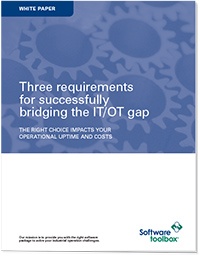Three requirements for successfully bridging the IT/OT Gap
Free White Paper

The convergence of IT and OT across industries is leading to a greater demand for access to data across a wider number of locations and users for many businesses.
We have found there are 3 key requirements that IT and OT professionals must consider in how they share data:
- Security
- Seamless Integration
- Real-Time Performance
When considering these 3 requirements, a common technology that is encountered in the OT world is OPC. Major software applications that need data from other systems have implemented OPC client interfaces. Those same applications, if they need to share data with other systems, have also implemented OPC server interfaces.
However, getting that OPC data from the factory floor to your IT systems and the staff that monitors those system to make decisions and act upon them has challenges. Many of those challenges are a result of the limitations of DCOM; the networking protocol used by the significant installed base of OPC applications.
In this whitepaper, you will learn more about the challenges in multi-computer, networked, and multi-site data integration architectures using OPC, including how OPC clients and servers connect, the role of a technology called DCOM, and how you can overcome them using a technology known as tunneling.
Contents:
- How OPC facilitates IT & OT convergence
- Review of how OPC Servers and Clients connect
- What is an OPC Tunnel?
- 4 Limitations of DCOM and their impact on your operations
- How to estimate the true cost to your business of using DCOM
- How using tunneling overcomes the limitations of DCOM
Complete the form at the right to receive an email with an immediate download of this free white paper.
Get the Whitepaper Now (Check Your Email Inbox)
STAY CONNECTED
1-888-665-3678 (US + Canada)
+1-704-849-2773 (Global)
+1-704-849-6388 (Fax)
support.softwaretoolbox.com
WORKING WITH US
WHO WE ARE
RECENT POSTS
Usage subject to our website terms and conditions.


